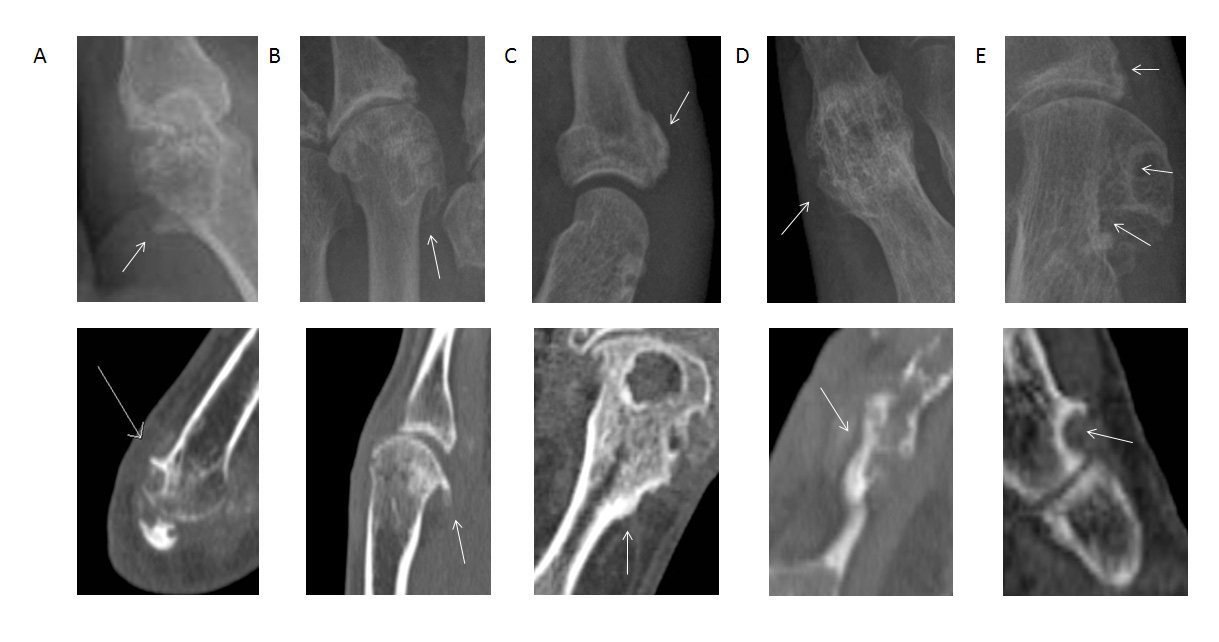Session Information
Session Type: Abstract Submissions (ACR)
Background/Purpose: Radiographic descriptions of gout have noted the tendency to hypertrophic bone changes. The aim of this study was to characterise the features of new bone formation (NBF) in gout, and to determine the relationship between NBF and other radiographic features of disease, particularly erosion and tophus.
Methods: Paired plain radiographs (XR) and computed tomography (CT) scans of 798 individual hand and wrist joints from 20 patients with gout were analyzed. Following a structured review of a separate set of images, films were scored for the presence of the following features of NBF: spur, osteophyte, periosteal NBF, ankylosis and sclerosis (Figure). Sites for NBF scoring were those included in the gout-modified Sharp-van der Heijde method for erosion scoring. The relationship between NBF and other imaging features of gout (erosion and tophus) was analysed.
Results: The most frequent forms of NBF were bone sclerosis (28.6% of all assessed joints using CT) and osteophyte (30.5%). Spur and periosteal NBF were less common (17.8% and 6.0% respectively) , and ankylosis was rare (0.6%). On both XR and CT, joints with bone erosion were more likely to have NBF; for XR, odds ratios (OR) 64.9 for spur, 64.9 for osteophyte, 119.8 for periosteal NBF, 30.1 for ankylosis and 101.1 for sclerosis (p for all <0.0001); and for CT, OR 45.1 for spur, 3.3 for osteophyte, 16.6 for periosteal NBF, 26.6 for ankylosis and 32.3 for sclerosis (p for all <0.01). Similarly, on CT, joints with intraosseous tophus were more likely to have NBF; OR 48.4 for spur, 3.3 for osteophyte, 14.5 for periosteal NBF, 35.1 for ankylosis and 39.1 for sclerosis (p for all <0.001).
Conclusion: This detailed quantitative analysis has demonstrated that NBF occurs more frequently in joints affected by other features of gout. This work suggests a connection between bone loss, tophus, and formation of new bone during the process of joint remodelling in gout.
Figure. Examples of the features of new bone formation (NBF) observed by plain radiography and computed tomography in patients with gout. A. Spur. B. Osteophyte. C. Periosteal NBF. D. Ankylosis. E. Sclerosis. Top panel shows plain radiographic images and lower panel shows CT images.
Disclosure:
N. Dalbeth,
None;
A. Milligan,
None;
B. Clark,
None;
F. M. McQueen,
None;
A. Doyle,
None.
« Back to 2012 ACR/ARHP Annual Meeting
ACR Meeting Abstracts - https://acrabstracts.org/abstract/characterisation-of-new-bone-formation-in-gout-a-quantitative-site-by-site-analysis-using-plain-radiography-and-computed-tomography/

